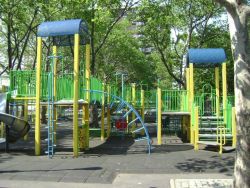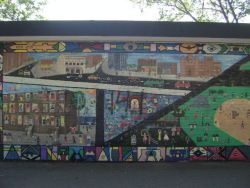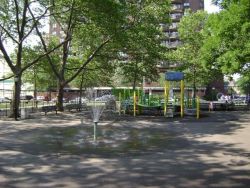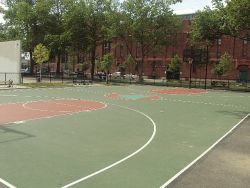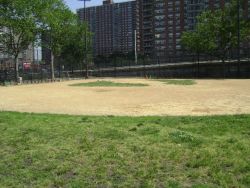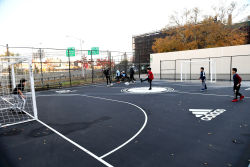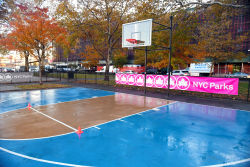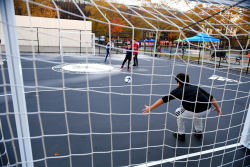Brigadier General Charles Young Playground
Brigadier General Charles Young Playground
What was here before?
Photos from the 1930s show the site occupied by a large gas station and auto repair shop, as well as an entrance to the 145th Street train station (which is now located at the corner of East 145th Street and Lenox Avenue).
How did this site become a playground?
The City acquired this property through condemnation in January 1944, and the playground opened to the public in September of that year. Built to accommodate a wide range of recreational interests, Colonel Young Playground features four basketball courts with bleachers, eight handball courts, four ball fields, a spray shower, play equipment, and swings. The playground was reconstructed in 2004, a project that included play and exercise equipment, safety surfacing, and a garden. In 2020, the park’s ballfield lighting was retrofitted to be more energy efficient.
Who is this playground named for?
This playground honors Brigadier General Charles Young (1864-1922), a pioneering African American army officer, cartographer, teacher, and diplomat.
Young was born in Mayslick, Kentucky on March 12, 1864 and moved to Ohio at age nine. He graduated from Ripley Colored High School in Ripley, Ohio in 1880. Young entered the United States Military Academy at West Point in 1884 as the ninth African American to do so. He was the third and last to graduate until nearly half a century later.
In 1894, he was assigned by the War Department to teach military science and tactics, French, and mathematics at Wilberforce University in Wilberforce, Ohio. Young served on the home front in the Spanish-American War (1898) and served two tours during the Philippine Insurrection (1901-03). In 1906, Young became military attaché to Haiti, the first African American military attaché in United States history. In addition to making maps, Young reported on Haitian society and government to the Army War College and wrote a book entitled Military Morale of Nations and Races (1912).
From 1912 to 1915, Young served as military attaché to Liberia, where he helped reorganize the National Military Constabulary. In 1916, the National Association for the Advancement of Colored People (NAACP) awarded him the Spingarn Medal for his work there. Young also established a school for African American soldiers at Fort Huachuca, Arizona. When he was found to be physically unfit for service in World War I, Young retired and was promoted to full Colonel. He died in Lagos, Nigeria on January 8, 1922 and is buried in Arlington National Cemetery. In 2022, Young was posthumously promoted from Colonel to Brigadier General by the Department of Justice.
The playground is located just north of the 369th Regiment Armory, home to the “Harlem Hellfighters,” an African American regiment that saw more combat than any other unit during World War I and was one of the most decorated. The playground and landmarked armory together celebrate African American military heritage.
Check out your park's Vital Signs
Clean & Safe
Green & Resilient
Empowered & Engaged Users
Share your feedback or learn more about how this park is part of a
Vital Park System

